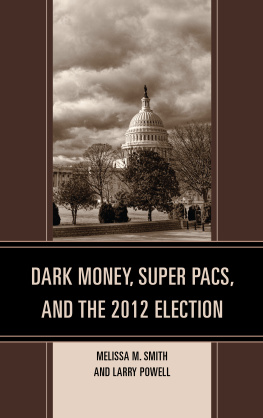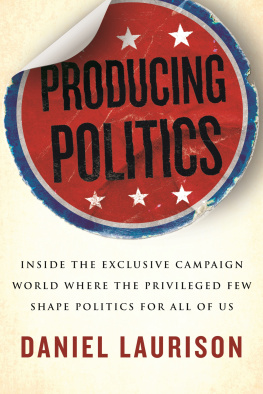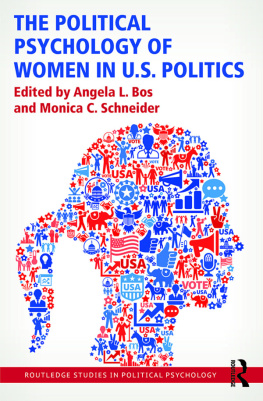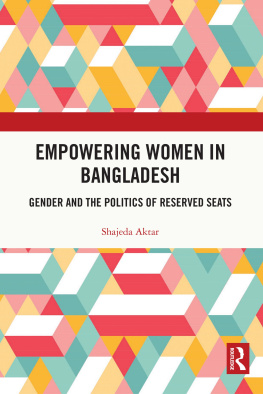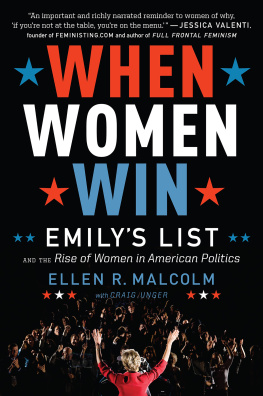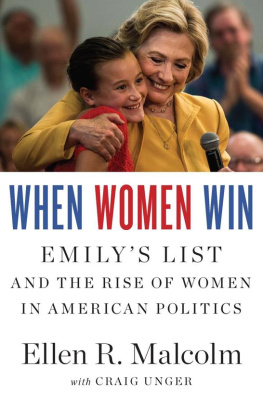WOMENS PACS
REAL POLITICS IN AMERICA
Series Editor: Paul S. Herrnson, University of Maryland
The books in this series bridge the gap between academic scholarship and the popular demand for knowledge about politics. They illustrate empirically supported generalizations from original research and the academic literature using examples taken from the legislative process, executive branch decision making, court rulings, lobbying efforts, election campaigns, political movements, and other areas of American politics. The goal of the series is to convey the best contemporary political science research has to offer in ways that will engage individuals who want to know about real politics in America.
Series Editorial Board
Scott Adler, University of Colorado
Christine L. Day, University of New Orleans
Kenneth M. Goldstein, University of WisconsinMadison
Rodney Hero, University of Notre Dame
Karen OConnor, American University
Kelly D. Patterson, Brigham Young University
John J. Pitney, Jr., Claremont McKenna College
Darrell M. West, Brown University
Clyde Wilcox, Georgetown University
WOMENS PACS
ABORTION AND ELECTIONS
Christine L. Day
University of New Orleans
Charles D. Hadley
University of New Orleans
First published 2005 by Pearson Education, Inc.
Published 2016 by Routledge
2 Park Square, Milton Park, Abingdon, Oxon OX14 4RN
711 Third Avenue, New York, NY 10017, USA
Routledge is an imprint of the Taylor & Francis Group, an informa business
Copyright 2005 Taylor & Francis. All rights reserved.
All rights reserved. No part of this book may be reprinted or reproduced or utilised in any form or by any electronic, mechanical, or other means, now known or hereafter invented, including photocopying and recording, or in any information storage or retrieval system, without permission in writing from the publishers.
Notice:
Product or corporate names may be trademarks or registered trademarks, and are used only for identification and explanation without intent to infringe.
Credits and acknowledgments borrowed from other sources and reproduced, with permission, in this textbook appear on appropriate page within text.
ISBN : 9780131174481 (pbk)
Cover Designer: Bruce Kenselaar
Library of Congress Cataloging-in-Publication Data
Day, Christine L.
Womens PACs: abortion and elections/Christine L. Day, Charles D. Hadley.
p. cm.(Real politics in America)
Includes bibliographical references and index.
ISBN 0-13-117448-7
1. Women in politicsUnited States. 2. Political action committeesUnited
States. I. Hadley, Charles D. II. Title. III. Series.
| HQ1236.5.U6D39 2005 |
| 320.082dc22 | 2004016570 |
For Steve and for Nathaniel
M any people helped with this project from early survey design to final book production, and we are grateful to all. Robert Biersack of the Federal Election Commission was very helpful in compiling the FEC data on which we based the mailing lists for the contributor survey. M. Kent Jennings kindly shared ideas from the questionnaire for his own NAMES Project Volunteer Survey. Research assistants George S. Chambers, Ursula Daxecker, Megan Duffy Brown Hubbard, Hannes Richter, Sabine Schafer, and Catherine R. Setzer helped us organize the data, mail surveys, and track down information both here and at the FEC office in Washington, D.C. Kerry Hutchinson, Regina Pirolozzi, and Nicole Scott provided invaluable administrative assistance.
Several people read early chapter drafts or papers related to this project, enabling us to shape and improve it with their ideas: Lisa A. Baldez, Lee Ann Banaszak, Robert Biersack, Barbara C. Burrell, Rosalyn Cooperman, Victoria A. Farrar-Myers, John C. Green, Eric S. Heberlig, and Laura R. Woliver. Laurel Elder of Hartwick College, Susan Johnson of the University of WisconsinWhitewater, and Kendra Stewart of Eastern Kentucky University also read the entire manuscript and offered invaluable advice. Real Politics in America series editor Paul S. Herrnson encouraged us to bring our research together in a book, offering helpful and insightful suggestions that made this a far better book. Members of the Prentice Hall editorial staff offered friendly and efficient professional assistance; we give special thanks to Glenn Johnston, Beth Mejia, Charlyce Jones Owen, and Suzanne Remore.
A portion of the material in .
The College of Liberal Arts at the University of New Orleans provided funding for the Womens PAC Contributor Survey and related research through a series of faculty research and faculty development grants. The Washington Academic Internship Program of the John Glenn Institute for Public Service and Public Policy at The Ohio State University, directed by Elizabeth M. Boles, and the Center for American Politics and Citizenship at the University of Maryland, directed by Paul S. Herrnson, generously provided office space, use of facilities, and copious amounts of coffee while Christine was conducting interviews in Washington, D.C.
Finally, we are grateful to the leaders of EMILYs List, The WISH List, and the Susan B. Anthony List, who cheerfully consented to personal interviews, and to the contributors to all three organizations who took the time to respond to our survey.
Christine L. Day
Charles D. Hadley
F emale politicians, and the womens political action committees (PACs) that support them, are extremely diverse. But together, they are changing the male-dominated face of American politics. By 2004, the number of women in Congress had never surpassed 14 percent. But it was higher than ever before, and it had more than tripled in three decades. Eight women served as state governors, only 16 percent, but also more than ever before. No woman had ever been elected president or vice president, but Democrat Geraldine Ferraro in 1984 had been on a major-party ticket as a vice presidential candidate. Women had increased their representation at every level in every branch of government. Gradually, the political glass ceiling that prevents women from achieving parity in politics is beginning to crack.
Womens PACs, founded by women to raise money primarily or exclusively for female candidates, stand at the nexus of political change and politics as usual: bringing women into positions of power by mastering the political money game. Like female activists and candidates, womens PACs extend across the partisan and ideological spectrum. This book focuses on three of them, reflecting the range of partisan and ideological positions among womens PACs. They are as follows:



